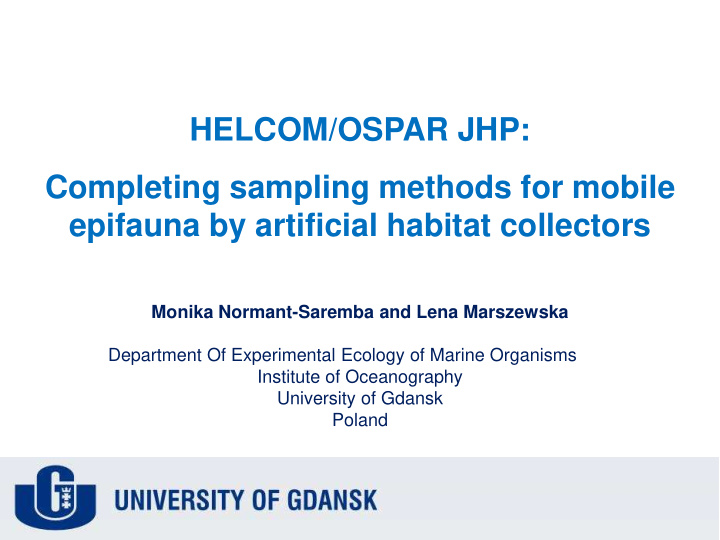



HELCOM/OSPAR JHP: Completing sampling methods for mobile epifauna by artificial habitat collectors Monika Normant-Saremba and Lena Marszewska Department Of Experimental Ecology of Marine Organisms Institute of Oceanography University of Gdansk Poland
MOBILE EPIFAUNA Epifauna - aquatic animals, that live on the surface of a bottom or on the surface of a submerged substrate, such as rocks or aquatic plants and animals; Photo: Monika Normant- Saremba Photo: Monika Normant- Saremba (Ojaveer et al., 2016) among target species being on the lists that are currently in use in the HELCOM and OSPAR areas, 27% and 22% belong to mobile epifauna; Photo: Jarosław Samsel
JHP: MOBILE EPIFAUNA SAMPLING (baited traps) JHP: “Mobile epifauna, such as crabs, should be sampled at each sampling site using light weight traps tethered to existing structures (pilings, buoys, docks). Traps are selective in nature and therefore provide only information on the presence of species” Gee-minnow trap Fukui box trap (42 x 23 x 20 cm, with 2.5 cm mouth and (63 x 42 x 20 cm, with 1.3 cm mesh netting) 6.4 mm netting) BAITED TRAPS deployed for at least 48 h Photo: Monika Normant- Saremba Photo: Monika Normant- Saremba
MOBILE EPIFAUNA REQUIRE SHELTERS bottom hardening constructions (Port of Gdynia examples); Photo: ZMPG- a S.A. Photo: ZMPG- a S.A. sacks filled with sand horizontal gabion walls (size: 1.5 or 2.0 or 3.0 x 1.5 x 0.5 m) (size: 1.5 x 2.0 x 0.5 m; 3.0 x 6 x 0.5 m ; with 10 cm disposed up to 30 m from port quays netting)
Photo: ZMPG- a S.A.
MOBILE EPIFAUNA SAMPLING (non-baited traps) ’Crab condo’ ’Oyster crate’ PVC tubes (3 x 3), 5 x 25 cm plastic crate 30 x 30 x 30 cm filled with (Hewitt & McDonald , 2013) oyster shells (Fowler et al., 2013) ARTIFICIAL HABITAT COLLECTORS deployed for 4-6 weeks Photo: Monika Normant- Saremba Photo: Monika Normant- Saremba Photo: Monika Normant- Saremba
BAITED vs. NON-BAITED TRAPS (crustaceans) NUMBER OF TRAPPED SPECIES (May-October 2014) Fukui Gee-minnow Crab condo Oyster crate Order (n=21) (n=21) (n=6) (n=6) Mysida 2 Isopoda 1 1 2 4 Amphipoda 6 6 Decapoda 2 3 1 2 SUM 3 4 11 11 ABUNDANCE OF TRAPPED TAXA (May-October 2014) Mysida 4 Isopoda 8 7 4 155 Amphipoda 158 3131 Decapoda 7 23 12 75 SUM 15 30 178 3361 only 3 species (1 isopod, 2 decapods) were common for baited and Photo: Piotr Wysocki non-baited traps; 1 decapod was found only in baited traps; as many as 12 species were found only in non-baited traps (2 mysids, 3 isopods, 7 amphipods); Photo: Monika Normant- Saremba
ONE NEW SPECIES DETECTED (oyster traps) 10 North American amphipod Melita nitida (photo:C. d’Udekem d’Acoz and F. Kerckhof , RBINS ) Map showing chronological records of M. nitida in European coastal waters (Normant- Saremba et al., in press).
CONCLUSION The ability to detect higher number as well as abundance of species representing mobile epifauna indicates that artificial habitat collectors would be an useful addition to baited traps described in Detailed Port Survey Protocol (Annex 2). Photo: ZMPG- a S.A. Port of Gdynia ( - sampling sites)
Recommend
More recommend